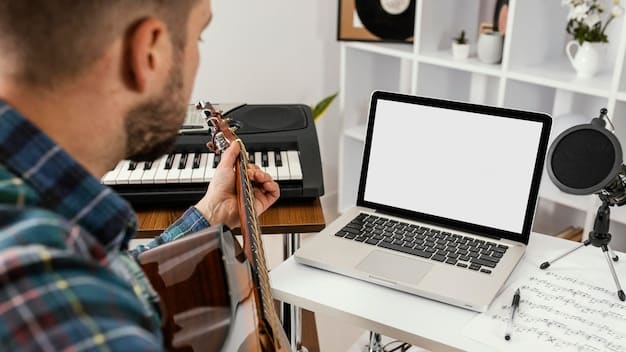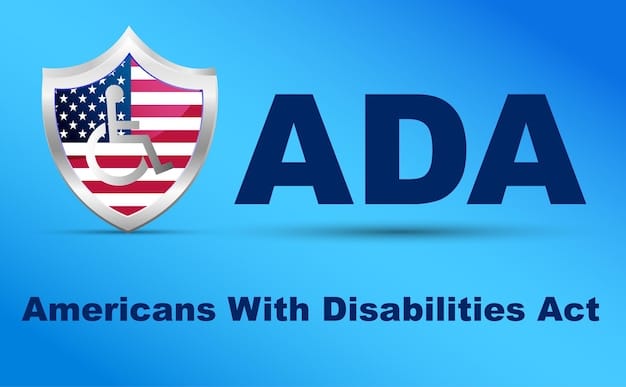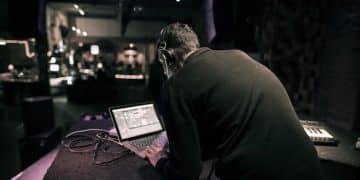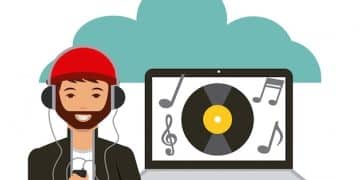The Ultimate Guide to Music Licensing: Monetize Your Music in the US

The Ultimate Guide to Music Licensing offers a comprehensive overview for musicians in the US looking to generate passive income by licensing their music, covering everything from understanding copyright to navigating licensing agreements and maximizing earning potential.
Are you a musician looking to generate passive income from your creative work? The Ultimate Guide to Music Licensing: Earn Passive Income by Licensing Your Music in the US provides a detailed roadmap for navigating the complex world of music licensing, empowering you to monetize your music effectively.
Understanding Music Licensing: A Gateway to Passive Income
Music licensing is the process of granting permission for others to use your copyrighted music in various contexts. This can range from film and television to advertising and video games. Understanding the different types of licenses and how they work is crucial for any musician looking to generate passive income.
This comprehensive guide will walk you through everything you need to know about music licensing in the US, from the basics of copyright law to the intricacies of negotiating licensing agreements.
What is a Music License?
A music license is essentially a contract that allows someone to use your music legally. Without a license, any unauthorized use of your music constitutes copyright infringement. Licenses specify the terms of use, including how the music can be used, how long it can be used for, and the compensation you will receive.
Types of Music Licenses
There are several types of music licenses, each covering different uses of your music:
- Synchronization License: Allows the use of your music in visual media such as films, TV shows, and video games.
- Mechanical License: Grants permission to reproduce and distribute your music in physical or digital formats.
- Performance License: Covers the public performance of your music, whether it’s played on the radio, in a concert, or in a restaurant.
- Print License: Allows the reproduction and distribution of your music in printed form, such as sheet music.
Understanding these different types of licenses is essential for effectively managing your music rights and maximizing your income potential.
In conclusion, music licensing provides a legal framework for using copyrighted music, with various types of licenses addressing different usage scenarios. Gaining a clear understanding of these licenses will empower musicians to protect their rights and unlock passive income streams.
Copyright Basics: Protecting Your Musical Creations
Copyright law is at the heart of music licensing. It grants you, as the composer or songwriter, exclusive rights over your musical creations. Understanding copyright is the first step towards effectively licensing your music and earning passive income.
This section will delve into the fundamentals of copyright law in the US, explaining what it protects, how to register your copyrights, and how long copyright protection lasts.

What Does Copyright Protect?
Copyright protects original works of authorship, including musical compositions and sound recordings. This protection gives you the exclusive right to:
- Reproduce your work
- Distribute copies of your work
- Prepare derivative works based on your work
- Publicly perform your work
- Publicly display your work
Registering Your Copyright
While copyright protection exists automatically upon the creation of your music, registering your copyright with the US Copyright Office provides significant legal advantages. Registration allows you to sue for infringement and recover statutory damages and attorney’s fees.
Duration of Copyright Protection
For works created after 1977, copyright protection generally lasts for the life of the author plus 70 years. For corporate works (works made for hire), the term is 95 years from publication or 120 years from creation, whichever expires first.
In summary, copyright law protects original musical compositions and sound recordings, granting exclusive rights to the creator. Registering your copyright with the US Copyright Office strengthens your legal position and enhances your ability to enforce your rights. Understanding these basics is critical for effectively licensing your music.
Navigating Performing Rights Organizations (PROs)
Performing Rights Organizations (PROs) play a critical role in collecting royalties for the public performance of your music. Joining a PRO is essential for ensuring that you receive fair compensation when your music is played on the radio, online, or in public venues.
This section will provide an overview of the major PROs in the US, explaining their functions, how they operate, and how to join one.
What are PROs?
PROs are organizations that collect performance royalties on behalf of songwriters and music publishers. They monitor public performances of music and distribute royalties to their members based on the frequency and type of usage.
Major PROs in the US
The major PROs in the US include:
- ASCAP (American Society of Composers, Authors and Publishers): One of the largest PROs in the US, representing a wide range of songwriters and publishers.
- BMI (Broadcast Music, Inc.): Another major PRO, known for its diverse membership and extensive catalog.
- SESAC (Society of European Stage Authors and Composers): A smaller PRO with a more selective membership, often focusing on independent artists and publishers.
How to Join a PRO
To join a PRO, you will need to complete an application and pay a membership fee. Each PRO has its own specific requirements and application process.
In short, Performing Rights Organizations (PROs) collect royalties for the public performance of music, ensuring that songwriters and publishers receive fair compensation. Joining a PRO like ASCAP, BMI, or SESAC is crucial for maximizing your income from music licensing.

Synchronization Licensing: Music in Visual Media
Synchronization licensing, often referred to as “sync” licensing, is one of the most lucrative areas of music licensing. It involves granting permission to use your music in visual media, such as films, TV shows, commercials, and video games.
This section will explore the ins and outs of sync licensing, explaining how it works, how to find sync licensing opportunities, and how to negotiate sync licenses.
How Sync Licensing Works
When a filmmaker, TV producer, or video game developer wants to use your music in their project, they need to obtain a sync license. This license grants them the right to synchronize your music with their visual content. The fee for a sync license varies depending on several factors, including:
- The popularity of the music
- The length of the music used
- The type of media (film, TV, commercial, video game)
- The distribution of the media
Finding Sync Licensing Opportunities
There are several ways to find sync licensing opportunities:
- Networking: Build relationships with filmmakers, TV producers, and music supervisors.
- Music Libraries: Submit your music to online music libraries that specialize in sync licensing.
- Direct Outreach: Contact production companies and ad agencies directly to pitch your music.
Negotiating Sync Licenses
Negotiating a sync license can be complex, but it’s essential to understand the value of your music and to advocate for fair compensation. Key terms to negotiate include:
- The fee: The amount of money you will receive for the license.
- The term: The length of time the license is valid.
- The territory: The geographic area the license covers.
- Usage rights: The specific ways the music can be used.
To summarize, synchronization licensing involves granting permission to use music in visual media, offering a lucrative avenue for generating passive income. Finding opportunities requires networking, utilizing music libraries, and direct outreach, while negotiating favorable terms is crucial for maximizing your earnings.
Mechanical Licensing: Reproduction and Distribution
Mechanical licensing covers the reproduction and distribution of your music in physical and digital formats. This includes CDs, vinyl records, digital downloads, and streaming services.
This section will examine the mechanics of mechanical licensing, explaining how it works, how royalties are calculated, and how to collect mechanical royalties.
How Mechanical Licensing Works
Whenever someone reproduces and distributes your copyrighted music, they need to obtain a mechanical license. This license grants them the right to manufacture and sell copies of your music. In the US, mechanical royalties are typically paid to the songwriter or publisher.
Calculating Mechanical Royalties
In the US, the statutory mechanical royalty rate is set by the Copyright Royalty Board. As of 2024, the rate is:
- 9.1 cents for songs five minutes or less
- 1.75 cents per minute for songs over five minutes
Collecting Mechanical Royalties
There are several ways to collect mechanical royalties:
- Direct Collection: You can collect mechanical royalties directly from record labels and distributors.
- Harry Fox Agency (HFA): HFA is a licensing and royalty collection agency that represents many music publishers.
- The Mechanical Licensing Collective (The MLC): The MLC is a non-profit organization that collects and distributes digital mechanical royalties in the US.
In essence, mechanical licensing covers the reproduction and distribution of music in various formats, with royalties calculated based on statutory rates. Songwriters and publishers can collect these royalties directly or through agencies like HFA or The MLC, ensuring compensation for the reproduction of their work.
Maximizing Your Earning Potential: Tips and Strategies
Successfully licensing your music requires more than just understanding the basics of copyright and licensing. It also involves actively pursuing opportunities and implementing effective strategies to maximize your earning potential.
This section will provide practical tips and strategies for promoting your music, building relationships, and negotiating favorable licensing deals.
Promoting Your Music
The more exposure your music receives, the more licensing opportunities will come your way. Consider these strategies:
- Create a Professional Website: Showcase your music and provide contact information for licensing inquiries.
- Utilize Social Media: Share your music on social media platforms and engage with potential licensees.
- Attend Industry Events: Network with filmmakers, TV producers, and music supervisors at industry events.
Building Relationships
Building strong relationships with key players in the music industry is essential for long-term success. This includes:
- Music Supervisors: These professionals are responsible for selecting and licensing music for films, TV shows, and commercials.
- Production Companies: Develop relationships with production companies that produce visual media.
- Ad Agencies: Connect with ad agencies that use music in their advertising campaigns.
Negotiating Favorable Licensing Deals
When negotiating licensing deals, be prepared to advocate for fair compensation and favorable terms. Consider these tips:
- Know Your Worth: Research the going rates for similar licenses and be prepared to negotiate accordingly.
- Protect Your Rights: Ensure that the license agreement clearly defines the scope of usage and protects your copyright.
- Seek Legal Advice: If you’re unsure about any aspect of the licensing agreement, consult with an attorney specializing in music law.
In conclusion, maximizing earning potential in music licensing requires promoting your music to gain exposure, building strong relationships with industry professionals, and negotiating favorable licensing deals. By actively pursuing these strategies, musicians can unlock significant passive income streams from their creative work.
| Key Aspect | Brief Description |
|---|---|
| 📝 Copyright | Protects original musical works, giving exclusive rights to the creator. |
| 🎤 PROs | Collect performance royalties for public performance of music. Join ASCAP, BMI, or SESAC. |
| 🎬 Sync Licensing | Allows music use in films, TV, and games. Negotiate fees and usage rights. |
| 🎵 Mechanical Licensing | Covers reproduction and distribution. Royalties collected via HFA or The MLC. |
Frequently Asked Questions
▼
A sync license allows your music to be used in visual media, like films or games, while a mechanical license covers the reproduction and distribution of your music in physical or digital formats.
▼
While copyright protection exists automatically, registering with the US Copyright Office offers legal advantages, allowing you to sue for infringement and claim damages.
▼
PROs like ASCAP, BMI, and SESAC collect performance royalties on behalf of songwriters and publishers, ensuring they get paid when their music is publicly performed.
▼
Know your worth, protect your rights by clearly defining usage scope, and consider seeking legal advice to ensure fair compensation and favorable terms in your agreement.
▼
Create a professional website, use social media, and attend industry events to network with potential licensees. The more visible your music is, the more opportunities will arise.
Conclusion
Music licensing presents a significant opportunity for musicians in the US to generate passive income by leveraging their copyrighted works. By understanding the different types of licenses, copyright law, and the role of PROs, musicians can effectively manage their music rights and unlock new revenue streams.





